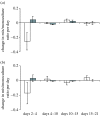Effect of dispersal and nutrient availability on the competitive ability of toxin-producing yeast
- PMID: 18182371
- PMCID: PMC2596812
- DOI: 10.1098/rspb.2007.1461
Effect of dispersal and nutrient availability on the competitive ability of toxin-producing yeast
Abstract
The ecological role of interference competition through toxin production is not well understood. In particular, it is unclear under what conditions the benefits of toxic killing outweigh the metabolic costs involved. A killer advantage has been suggested to rely on local competitive interactions where the benefits of killing accrue to the toxin producer preferentially, but this notion has little empirical support. In addition, contrasting predictions exist about the effect of resource abundance on the benefits of toxin production; this benefit should either be highest when resources are abundant and metabolic costs are relatively low or when resources are scarce and toxic killing is a 'last resort strategy' to obtain nutrients. Here, we test these predictions for one aspect of competitive ability, that is, the ability of toxin producers to invade a population of sensitive non-producers from a low initial frequency. We use competition experiments between isogenic K1 toxin-producing and non-producing strains of Saccharomyces cerevisiae, where we manipulate dispersal under two extreme nutrient conditions: one environment with and the other without replenishment of nutrients. We find that toxin production is beneficial when dispersal is limited under both nutrient conditions, but only when resources are abundant these outweigh its cost and allow invasion of the producer.
Figures



References
-
- Baganz F, Hayes A, Marren D, Gardner D.C.J, Oliver S.G. Suitability of replacement markers for functional analysis studies in Saccharomyces cerevisiae. Yeast. 1997;13:1563–1573. doi:10.1002/(SICI)1097-0061(199712)13:16<1563::AID-YEA240>3.0.CO;2-6 - DOI - PubMed
-
- Brown S.P, Le Chat L, De Paepe M, Taddei F. Ecology of microbial invasions: amplification allows virus carriers to invade more rapidly when rare. Curr. Biol. 2006;16:2048–2052. doi:10.1016/j.cub.2006.08.089 - DOI - PubMed
-
- Carreiro S.C, Pagnocca F.C, Bacci M, Jr, Bueno O.C, Hebling M.J, Middelhoven W.J. Occurrence of killer yeasts in leaf-cutting ant nests. Folia Microbiol. (Praha) 2002;47:259–262. - PubMed
-
- Case T.J, Gilpin M.E. Interference competition and niche theory. Proc. Natl Acad. Sci. USA. 1974;71:3073–3077. doi:10.1073/pnas.71.8.3073 - DOI - PMC - PubMed
-
- Chao L, Levin B.R. Structured habitats and the evolution of anticompetitor toxins in bacteria. Proc. Natl Acad. Sci. USA. 1981;78:6324–6328. doi:10.1073/pnas.78.10.6324 - DOI - PMC - PubMed
Publication types
MeSH terms
Substances
LinkOut - more resources
Full Text Sources
Molecular Biology Databases

